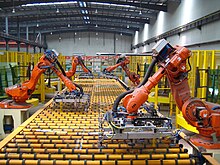Production

Following the glass batch preparation and mixing, the raw materials are transported to the furnace. Soda-lime glass for mass production is melted in gas fired units. Smaller scale furnaces for specialty glasses include electric melters, pot furnaces, and day tanks. After melting, homogenization and refining (removal of bubbles), the glass is formed. Flat glass for windows and similar applications is formed by the float glass process, developed between 1953 and 1957 by Sir Alastair Pilkington and Kenneth Bickerstaff of the UK's Pilkington Brothers, who created a continuous ribbon of glass using a molten tin bath on which the molten glass flows unhindered under the influence of gravity. The top surface of the glass is subjected to nitrogen under pressure to obtain a polished finish. Container glass for common bottles and jars is formed by blowing and pressing methods. This glass is often slightly modified chemically (with more alumina and calcium oxide) for greater water resistance.
Once the desired form is obtained, glass is usually annealed for the removal of stresses and to increase the glass's hardness and durability. Surface treatments, coatings or lamination may follow to improve the chemical durability (glass container coatings, glass container internal treatment), strength (toughened glass, bulletproof glass, windshields), or optical properties (insulated glazing, anti-reflective coating).
New chemical glass compositions or new treatment techniques can be initially investigated in small-scale laboratory experiments. The raw materials for laboratory-scale glass melts are often different from those used in mass production because the cost factor has a low priority. In the laboratory mostly pure chemicals are used. Care must be taken that the raw materials have not reacted with moisture or other chemicals in the environment (such as alkali or alkaline earth metal oxides and hydroxides, or boron oxide), or that the impurities are quantified (loss on ignition). Evaporation losses during glass melting should be considered during the selection of the raw materials, e.g., sodium selenite may be preferred over easily evaporating selenium dioxide (SeO2). Also, more readily reacting raw materials may be preferred over relatively inert ones, such as aluminum hydroxide (Al(OH)3) over alumina (Al2O3). Usually, the melts are carried out in platinum crucibles to reduce contamination from the crucible material. Glass homogeneity is achieved by homogenizing the raw materials mixture (glass batch), by stirring the melt, and by crushing and re-melting the first melt. The obtained glass is usually annealed to prevent breakage during processing.
Colour
Colour in glass may be obtained by addition of homogenously distributed electrically charged ions (or colour centres). While ordinary soda-lime glass appears colourless in thin section, iron(II) oxide (FeO) impurities produce a green tint in thick sections. Manganese dioxide (MnO2), which gives glass a purple colour, may be added to remove the green tint given by FeO. FeO and chromium(III) oxide (Cr2O3) additives are used in the production of green bottles. Iron (III) oxide, on the other-hand, produces yellow or yellow-brown glass. Low concentrations (0.025 to 0.1%) of cobalt oxide (CoO) produces rich, deep blue cobalt glass. Chromium is a very powerful colourising agent, yielding dark green. Sulphur combined with carbon and iron salts produces amber glass ranging from yellowish to almost black. A glass melt can also acquire an amber colour from a reducing combustion atmosphere. Cadmium sulfide produces imperial red, and combined with selenium can produce shades of yellow, orange, and red. The additive Copper(II) oxide (CuO) produces a turquoise colour in glass, in contrast to Copper(I) oxide (Cu2O) which gives a dull brown-red colour.

Iron(II) oxide and chromium(III) oxide additives are often used in the production of green bottles.

Cobalt oxide produces rich, deep blue glass, such as Bristol blue glass.

Different oxide additives produce the different colours in glass: turquoise (Copper(II) oxide), purple (Manganese dioxide), and red (Cadmium sulfide).
Red glass bottle with yellow glass overlay
Amber-coloured glass

Four-colour Roman glass bowl, manufactured circa 1st century B.C.






Comments
Post a Comment